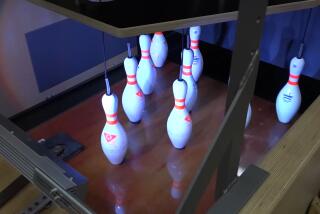GAMES : Parlor Game Transformed Into a Whole New Racket
- Share via
Let’s agree right from the get-go not to call it Ping-Pong. At least not while the pros are listening. After all, it’s the most popular racket sport in the world, so we ought to get it right: It’s table tennis.
And it ain’t the game Grandpa played. When it began in America in the early 1900s, it was considered a genteel parlor game, played by people of refined temperament and stately movement. By 1988 it had become an Olympic sport, and if the big matches had been played in parlors, the furniture would have been shattered to matchsticks before the third point.
You’ve seen them: hyperkinetic as hummingbirds, darting back and forth, up and down, bouncing as if the floor were hot iron, flailing the air like Bruce Lee in the middle of a killer bee attack. These are the elite players, who often drive the little ball past each other at more than 80 m.p.h. with rackets (don’t call them paddles) that you definitely can not file your nails with.
But what about you, the person of refined temperament and stately movement? Can anybody here still play this game?
Sure. But if table tennis has reached a higher level, why not you too? Let’s review the essentials of the good old parks ‘n’ rec game:
The Rules
Games are played to a score of 21, and matches are two games out of three or three out of five. Players alternate serves every five points. And remember to serve by throwing the ball at least six inches straight up from a flat, open palm and hitting it on the descent.
The Table
You’ve seen the warped ones left out in the rain, but you’ll want to baby the best of them. Prices range from around $125 for “recreational” tables to more than $500 for tournament-grade tables approved by the U.S. Table Tennis Assn.
And if you want to play the game the way God and the U.S. Table Tennis Assn. intended, you’ll want to keep dimensions in mind. The standard table is 9 feet long, 5 feet wide and 2 1/2 feet high. The USTTA rules allow for a minimum playing space of 40 feet in length, 20 feet in width and 11 1/2 feet in height.
The Racket
Get this: The rules say it can be “any size, shape or weight.” The really nifty ones are made from wood covered with a layer of cellular rubber followed by an outer layer of pimpled rubber. The pimples are often inverted so that the outer surface is smooth, sticky rubber. It can cost you, but it’s your weapon. Believe it or not, you can still buy a racket covered in nothing but sandpaper for about $3, but you can also order a custom racket (you choose the components from a list of custom materials, and the dealer assembles it) for between $50 and $150.
The Grip
There are three. The “shake-hands” grip is the most popular and is accomplished, as the name implies, by holding the racket as if shaking hands with it. It offers the best balance. The “pen hold,” in which the racket is held like a pencil or pen, offers a great forehand but a weaker backhand. The “Seemiller,” an unorthodox grip introduced by five-time U.S. national champion Dan Seemiller, is a version of the shake-hands grip in which the racket is rotated so the forehand side can also be used on the backhand.
Styles of Play
You are, apparently, how you hit. The “defender” returns everything, wearing down his opponent, waiting for a mistake. The “pick hitter” is a defender who waits for the perfect shot and kills it. The “all-out attacker” is just that, a player who relies on aggressive returns and numerous kill shots. The “looper” is the offensive counterpart to the pick hitter. He uses the loop shot, which employs tremendous topspin, until the ball pops up high enough to kill.
The Benefits
The Chinese call table tennis “the people’s sport” because of its universal availability and appeal. It develops sharp hand/eye coordination, and an enthusiastically played 30-minute match burns about 150 calories in a 150-pound person. The elite players take this seriously and include distance running and weight work in their training rituals. These people are tough.
So smile when you say Ping-Pong.


